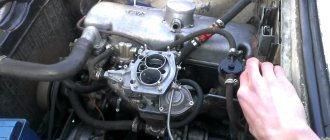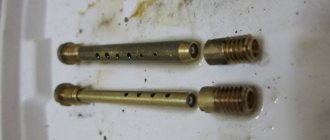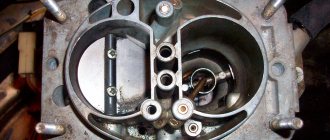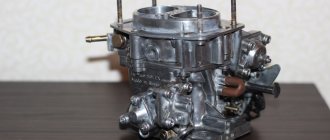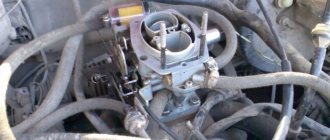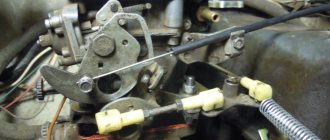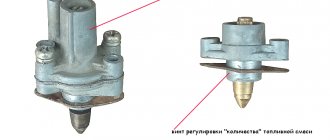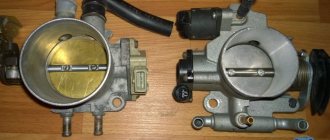As a rule, they select the types of jets for the Solex 21073 carburetor while adjusting it on the engine. Some drivers sometimes think that if a dream has come true, and Solex is finally installed on the car, then all problems will be resolved at once. But it was not there! The main work only begins after installation. Solex, designed to save you money on fuel resources, in order for it to function correctly, it also needs to be finely tuned.
It’s good if you know a carburetor mechanic. And if not? You can try to make the adjustment yourself, but for this procedure you need to know at least more information about the carburetor itself.
Selecting the types of jets for the Solex 21073 carburetor is one of the components of its configuration for the most reasonable further operation. And before replacing one with another, you need to fundamentally understand: why, and what kind of detail is this?
Adjusting the Solex carburetor
First, about why adjusting the carburetor at all. Solex gained a reputation as the most reliable among VAZ carburetors, so they began to install it on other brands, in particular on Oka. And, of course, after such tuning you need to adjust the fuel supply.
This procedure is also necessary after cleaning or repair has been carried out, when the carburetor has been dismantled and disassembled.
What exactly is regulated in Solex:
- Filling the float chamber;
- Idle speed.
Below, in the video, it is clearly explained how to make simple Solex adjustments without instruments.
The fuel level in the float chamber is important for uninterrupted supply while driving. Lack or overfilling can lead to engine malfunctions, increased gasoline consumption, and engine operation on an over-enriched mixture. The carburetor does not need to be removed for adjustment. Procedure:
- Start the engine and warm it up to operating temperature;
- Stop the engine and disconnect the fuel supply cable. Make sure that gasoline does not overflow back into the carburetor; take care of a container for it in advance;
- Unscrew the fastenings of the carburetor cover, disconnect the choke cable, and only then remove the cover;
- Each chamber will contain a certain amount of gasoline. It is necessary to measure the height of the empty space of the chambers, from the surface of the liquid to the top. Since the filling of the chambers will most likely be different, the arithmetic average is calculated - add the indicators and divide by two;
- The normal figure is 24-26 mm. If there is more or less gasoline, the float is adjusted (carefully bent in the desired direction), after which the measurements must be taken again.
Idle speed (idle speed) is adjusted by setting the idle speed and adjusting the optimal fuel supply to idle speed. Adjustment sequence:
- Start the engine and warm it up to operating temperature, turn it off;
- Turn the “mixture quality” screw (located in the lower part of the body) to the right until it stops, and then loosen it 3-6 turns;
- Start the engine and remove the choke;
- Set the idle speed using the “quantity screw”. The optimal speed is 800-900 rpm, but not more than 1200 rpm;
- After this, we tighten the “quality screw” until the engine starts to work intermittently. As soon as we hear interruptions in operation, unscrew the screw 1-1.5 turns until we hear stable engine speeds, without jerking.
Operating principle
Solex carburetor float chamber ventilation system
Solex 21073 works as follows. Gasoline will enter the float chamber using the inlet fitting - the fuel also passes through the filter mesh, where it is cleaned, and goes through the needle valve. The chamber with the float is two-sectional, and the sections are connected to each other. They will contain the same amount of gasoline. This design makes it possible to significantly reduce the effect of body tilt on the fuel level in this chamber.
This ensures more stable engine operation. As the chamber fills, the float, pressing part of the needle valve, blocks the access of fuel to the chamber. This maintains a constant level of gasoline in the mechanism. Next, from the float chamber, gasoline flows through the jets into the mixing wells. Air enters these same wells through special holes in the emulsion tubes or air jets. Next, gasoline and air are mixed in them. As a result, a fuel mixture is formed. It will get into the small as well as large diffusers of the device. This is the main dosing chamber. Depending on the operating mode of the engine, certain mechanisms and systems can be started in the carburetor. When the owner tries to start the engine “cold” in order to enrich the fuel mixture, the starting device comes into play. The driver starts it from the passenger compartment - this is a choke.
When the handle is pulled out to its maximum, the air damper of the first chamber is completely closed. At the same time, the throttle valve in the first chamber opens to the distance of the starting gap. It is adjusted using the adjusting screw on the Solex carburetor. Adjusting the gap will allow you to adjust the idle speed.
Theory
The engine sucks air through the diffuser, and a certain amount of gasoline through the fuel nozzle. The volume of air and fuel sucked in depends on the volume of the engine. Therefore, the trend is to install a small jet for a larger engine volume. And if you have to install a similar Solex 21073 carburetor on a small engine (for example, 1.5), then the standard jets are poor (that is, they give an unsaturated mixture).
Therefore, we can say that it all starts with the fuel nozzle - its selection and settings. Afterwards, for the second time, you need to pick up an air one for it. Start strictly with the first camera until you have set it up; it is not recommended to work on the second one under any circumstances.
Rule:
We select the jets according to the engine volume. And before starting the setup, it’s best to find a factory Solex that matches the volume of the unit on your car, and rearrange (or install the same) jets from it.
Results
Of course, it is clear that there is no limit to improvements. Sometimes they can even go to excess: drilling, for example, a throttle valve, polishing an MD, soldering epulsion tubes on a carburetor. But, as they say, what is in excess is unhealthy. But such a procedure, fascinating in its own way, like selecting the types of jets for a Solex 21073 carburetor, for example, is something quite necessary for the correct setup of the unit and its complete compatibility with the engine compartment. As a result, you get an economical car that responds well to gas.
About 15 years ago I visited Tavria. The carb on it was a Solex. Gasoline consumption is less than 5 liters per hundred kilometers. Before the sale, the carb was replaced with a new one, 08 Solex, due to constant blockages, mainly in the XX system.
Carburetor jets 21073 Solex
The Solks 21073 carburetor of the Niva 21213 car has several jets in different systems. They allow you to accurately dose fuel, air, and emulsion entering the engine.
Fuel jets of the main metering systems (GDS) of the 1st and 2nd chambers of the Solex 21073 carburetor
The first chamber is 107.5, the second chamber is 117.5. See photo below.
Air jets of the main metering systems of the 1st and 2nd chambers of the Solex 21073 carburetor
The first chamber is 150, the second is 135.
fuel and air jets of the main metering systems (GDS) of the 21073 Solex carburetor
Calibrated hole in the fuel bypass fitting to the gas tank (return fitting)
calibrated hole in the fuel bypass fitting to the gas tank (“return”)
Fuel jet of the idle system (IAC) of the 21073 Solex carburetor
Calibration data - 39-44.
fuel jet of the idle speed system (IAC) of the 21073 Solex carburetor in the solenoid valve (EMV)
Air jet CXX carburetor 21073 Solex
air jet of the idle system (IAC) of the carburetor 21073 Solex
Fuel jet of the transition system of the second chamber of the carburetor 21073 Solex
See photo below. Marking - 70.
Fuel jet econostat carburetor 21073 Solex
econostat fuel jet and fuel jet of the transition system of the second chamber of the carburetor 21073 Solex with tubes
Fuel jet for economizer of power modes of carburetor 21073 Solex
fuel jet for economizer of power modes of carburetor 21073 Solex (economizer cover removed)
Notes and additions
— The location and number of Solex jets 2108, 21081, 21083 and other carburetors of this family are similar to the Solex carburetor 21073. Only their calibration data is different. Read more: “Solex carburetor jets.”
— Solex carburetor jets of various modifications are interchangeable, which creates a wide field for tuning and modification.
More articles on the design of the 21073 Solex carburetor
Scheme and principle of operation
The types and modifications of carburetors for a given car can be very different, but the principle of operation remains the same.
When starting the engine cold, the driver closes the choke to limit the flow of air and increase the amount of gasoline. This makes it easier to start and brings the speed necessary for stable operation.
Carburetor 21073 DaAZ device and principle of operation: diagram of the design and operation of the carburetor I - first chamber; II - second chamber; 1 — accelerator pump drive lever; 2 — adjusting screw of the starting device: 3 — diaphragm of the starting device; 4 — air channel of the starting device; 5 - solenoid shut-off valve; 6 — idle fuel jet; 7 — main air jet of the first chamber; 8 — idle air jet; 9 — air damper; 10 — sprayer of the main dosing system of the first chamber; 11 — accelerator pump nozzle; 12 — nozzle of the main dosing system of the second chamber: 13 — econostat nozzle: 14 — main air jet of the second chamber; 15 — air jet of the transition system of the second chamber; 16 — channel for balancing the float chamber; 17 - float chamber; 18 — needle valve; 19 — calibrated hole for fuel bypass into the tank; 20 — carburetor fuel filter; 21 — fuel supply fitting; 22 — power mode economizer diaphragm; 23 - fuel jet of the power mode economizer; 24 — ball valve of the power mode economizer; 25 - float; 26 — econostat fuel jet with tube; 27 — fuel nozzle of the transition system of the second chamber with a tube; 28 — emulsion tube of the second chamber: 29 — main fuel jet of the second chamber; 30 - outlet of the transition system of the second chamber; 31, 33 — throttle valves: 32 — slit of the transition system of the first chamber; 34 — outlet of the idle system; 35 — carburetor heating block; 30 - adjusting screw for the composition {quality} of the idle mixture; 37 — engine crankcase ventilation fitting; 38 - fitting for supplying vacuum to the vacuum ignition regulator; 39 — vacuum selection fittings for the recirculation system; 40 — main fuel jet of the first chamber; 41 — emulsion tube of the first chamber; 42 - ball valve of the accelerator pump; 43 — accelerator pump diaphragm.
During the warm-up process, air intake is increased to reduce speed and eliminate interruptions. Thus, the air damper opens completely and the amount of gasoline is reduced. Other methods of warming up are not provided for by the design.
Gasoline is supplied through the fuel filter to the float chamber, and then to the main metering system of the mixing chamber. The scheme for pumping air and mixing it with gasoline in the diffuser occurs due to the vacuum that occurs during the operation of the valve mechanism and pistons, compressing and pushing out the working mixture.
The second chamber system is designed to increase air flow to the nozzle when the engine is running under heavy load, when the speed is high.
To ensure that the engine runs stably at idle, and at low speeds to prevent it from stalling and eliminate interruptions, an idle system is provided. And to maintain the level of fuel used in the Solex 21073 carburetor, there is a whole scheme for the operation of the float system. Let's consider the operation of each system separately.
Idle system
In some situations, engine operation must be ensured even when the car is in neutral, when the speed is too low. At such a moment, the vacuum is insufficient and fuel will not be able to pass through the main metering chamber. A forced idle system is provided specifically for this purpose.
To do this, air is supplied through the main idle fuel jet into the first chamber. The fuel will then flow to the idle fuel jet. The air also passes through a special jet through a separate channel. This design allows the engine to operate even at low speeds, and when the throttle valve is opened, the power mode economizer begins working, which is considered as a transition system.
However, the system has a number of disadvantages when coasting:
- When the speed decreases by releasing the gas, fuel consumption continues;
- When switching to neutral gear, it increases completely.
Especially for this purpose, the calibration data also includes an EPHH, which turns off the fuel supply when coasting. Its operation continues until the speed drops to 1200 rpm and turns off when the throttle is opened. But when the car is stationary, it does not work.
Solex carburetor 073 — logbook Lada 2107 Lada 1500i 2003 on DRIVE2
There were a lot of problems with the old carburetor (DAAZ OZONE), failure when opening the damper of the second chamber (it opens there with a vacuum), there was no draft at all, it was filled with oil through crankcase gases and it did not want to be adjusted. Therefore, the thought of buying a Solex has long been on my mind, but only 21073 .
It so happened that a friend (from whom I bought the seven) also had problems with the carbure in the field, he bought a new one, also Solex 21073, but DAAZ, and gave the old one to me. The problem is that he’s PEKAR-ovsky) but I’m still glad)
It was very dirty on the outside and had a bit of oil on it. First of all, I took it apart, I thought I would see all sorts of dirt and oil there. and it was even very clean, I was delighted, put it back together) installed new red diaphragms (they have such a distinctive feature in appearance)), Evgeniy Travnikov reviewed them on YouTube. Next, we cleaned the outside with carburetor cleaner.
a friend is cleaning, and I’m sitting there taking pictures))
all the dirt and oil is now on the box)
Previously, this 7 had a Solex, so the choke cable from the 8 was already there, I installed long rods, since the throttle drive is on the other side, and a return hose with a valve.
return with valve and tee
I lowered the crankcase gas hoses (both large and small) downwards, which is not very environmentally friendly, but now the carb won’t be all in the oil)
After installation, noticeable traction appeared, there was no failure when opening the second chamber, in general, I got what I wanted) but still, this is a BAKER, so when starting off you can either stall or move off very slowly)) but it’s better than it was. And in the future I will also install a DAAZ Solex)
73rd Solex, because large diffusers (24x24, like), large jets that are not so sensitive to bad gasoline (they almost won’t clog), and the air jet of the second chamber, made together with the emulsion tube, is designed to work on a longitudinally mounted engine .
I will be glad if this information is useful to someone :)
www.drive2.ru
Basic Solex malfunctions and methods for eliminating them
Before looking for problems with the device, you need to make sure that the ignition system is working flawlessly and is adjusted correctly. You also need to check whether the timing belt is functioning correctly, since malfunctions in the operation of this mechanism can also cause malfunctions in the carburetor.
Table 1. Classification of possible carburetor malfunctions and methods for eliminating them.
| Malfunctions | Causes | Elimination methods |
| Difficulty starting a cold engine. | Incomplete closing of the air damper due to a broken spring or other mechanical obstacles. | Replace the spring and eliminate any problems that prevent the choke from closing. |
| Difficulty starting a hot engine. | High fuel level in the float chamber. | Adjust the fuel level. |
| Excessive fuel consumption. | Incomplete opening of the throttle valves, low fuel level in the float chamber, clogged fuel nozzle. | Adjust the damper and fuel level in the chamber. |
| Unstable engine operation. | Excessive enrichment or leanness of the mixture caused by malfunction of carburetor components, wear of the needle valve, or improper adjustment of the fuel level. | Change the needle valve, adjust the fuel level in the float chamber. |
| Interruptions in engine operation. | Malfunction of the dosing system or air leaks in the carburetor body connections. | Clean the fuel system, eliminate air leaks in the carburetor body. |
| Loss of engine power. | Malfunction of the secondary chamber throttle valve drive, decreased fuel level in the float chamber, clogged fuel nozzle. | Adjust the throttle valve drive and the fuel level in the float chamber, clean the fuel nozzle. |
| Dips during engine operation. | Damage to the diaphragm, accelerator pump, jamming of the nozzle drive lever, clogging of the idle fuel jet, incorrect installation of small diffusers. | Replace the diaphragm, eliminate the jamming of the drive lever, clean the jet, and install the diffuser correctly. |
Completion of diagnostics. Cleaning. Washing. Blowing
Final inspection of all parts and components. Detection of defects, damage, replacement with new ones from the repair kit.
The stage of washing and cleaning begins. For convenience, you can use special chemicals and aerosol cans. If you can’t purchase it, pour a little gasoline or kerosene into the container, this will be quite enough. All components are thoroughly washed, the cavities are cleaned of foreign debris, carbon deposits, and metal oxides. Cleaning proceeds to the drying stage and the beginning of assembly.
Be sure to blow through the following elements:
- idle jet;
- fuel nozzle channels of the first and second chambers;
- transition system channels;
- selection of crankcase gases;
- seat for the emulsion pipe;
- secondary chamber opening mechanism;
- trigger channel;
- accelerator pump mechanism.
During assembly, we check the clearances of the float chamber. The float should close at 6.3 mm. An increase or decrease in this indicator indicates level violations. This is when we are talking about this type of carburetor device. Before landing in a regular place, be sure to replace the asbestos gasket of the exhaust manifold with a new one. It is not recommended to install the old one back, since the exhaust site is already actually present, which means that the tightness and tightness of the fit are not guaranteed.
Folk method of adjusting the fuel level in the chambers:
The design of the carburetor provides for a protrusion inward at an angle of 45 degrees. Ideally, half of the above protrusion should be covered with gasoline. The desired level is achieved by pressing the tongue at the end of the float.
This is interesting: Emergency brake fluid change
The fastening nuts are tightened with a force of no more than 2.5 kg; exceeding this threshold leads to the so-called “licking” of the thread. Even though it has a fine pitch, especially for strong force, it is still susceptible to deformation.
Purpose and design of Solex carburetors
The production of licensed Solex carburetors began with the entry of front-wheel drive small cars into the domestic market.
On turns, steep climbs and maximum accelerations, previous models could not provide an engine located perpendicular to the direction of travel with a fuel-air mixture.
Features of Solex carburetors
Carburetors of the Solex family are not interchangeable with other models of DAAZ carburetors.
But within the family, various modifications are very similar to each other, differing slightly in the size of the metering elements and the shape of the control levers.
Various Solex modifications differ in the size of the dosing elements and the shape of the control levers
Thus, carburetors 21083 engines with a volume of 1.5 liters differ from carburetors 21081 engines with a volume of 1.1 liters, the diameters of the starting gaps of the dampers are increased by fractions of a millimeter.
In addition, some 21083 models have additional components and functions.
Table: features of various carburetor models
| Carburetor model | Peculiarities | Automobile model | Engine capacity, l |
| DAAZ 2108–1107010 |
| 1,3 | |
| DAAZ-21081–1107010 |
| 1,1 | |
| DAAZ-21083–1107010 |
| 1,5 | |
| DAAZ-21083–1107010–31 | semi-automatic starting device |
| 1,5 |
| DAAZ-21083–1107010–35 | two-stage starting device |
| 1,5 |
| DAAZ-21083–1107010–62 | electronic fuel mixture control |
| 1,5 |
| DAAZ-21083–1107010–05 | for engines with microprocessor ignition | VAZ-2109 | 1,5 |
| DAAZ-21412–1107010 | without drain fitting | AZLK-2141–01 | 1,5 |
| DAAZ-21412–1107010–30 | without drain fitting, for engines with microprocessor ignition | AZLK-2141–23 | 1,8 |
| DAAZ-1111–1107010 | inertial mixture enricher |
|
|
| DAAZ-21051–1107010 | traction drive of throttle valves, without drain fitting |
|
|
| DAAZ-21053–1107010 | traction drive of throttle valves, without drain fitting |
| 1,6 |
| DAAZ-21051–1107010–30 | traction drive of throttle valves, without drain fitting |
| 1,5 |
| DAAZ-21053–110701–62 | semi-automatic air damper drive |
|
|
| DAAZ-21073–1107010 | one accelerator pump nozzle |
|
|
Design and operating principle
A carburetor is an attachment that mixes air with gasoline in the optimal proportion for efficient engine operation.
Carburetor malfunctions make it difficult to start the engine, increase fuel consumption, reduce power and worsen vehicle dynamics.
Air and gasoline are mixed in a special chamber. Solex carburetors have two such chambers.
Usually only the first is used, and the second is connected only at high speeds.
The fuel pump delivers fuel to the float chamber through a needle valve.
If there is excess fuel, the floats rise, press the tongue on the needle and stop the flow of gasoline.
Excess fuel is returned to the tank through the return fitting.
The fuel is then mixed with air. To prevent excessive enrichment of the mixture, the fuel flow is slowed down by jets and emulsion tubes.
All these elements - a float with a needle valve, air and fuel nozzles, emulsion tubes and mixing chambers with dampers - form the main metering system.
In the carburetor, air is mixed with gasoline in the optimal proportion for efficient engine operation.
In addition to it, the carburetor includes:
- starting device;
- idle system;
- forced idle economizer (EFH);
- transition systems of mixing chambers;
- accelerator pump;
- power mode economizer (EMR);
- econostat;
- locking mechanism.
Wire screw quantity
The surprise of many car enthusiasts is the wire with a connector protruding from the carburetor.
This wire belongs to the forced idle economizer.
If the engine is standing without load, a signal from the carburetor is sent through this wire, and the EPHH shuts off the fuel supply.
A signal from the carburetor is received through the quantity screw wire and the EPHH stops the supply of gasoline
This system works as follows. When the driver releases the accelerator pedal, the flap blocks the air flow, the control lever returns to its original position and rests against the quantity adjusting screw.
The wire is connected to this screw. Touching the propeller lever is the signal sent to the EPH to stop the fuel supply.
Air damper
A malfunction of this section of the system will lead to a systematic loss of speed, and the engine will stall for no reason. To adjust, you will need a flat-tip screwdriver and an “8” open-end wrench. We push the suction rod all the way. Unscrew the rod clamp bolt as much as possible, insert the spring, and tighten the screw. We test equipment for performance.
The air damper drive must be adjusted with a partner. For convenience, you will need an open-end wrench set to “8”, a lighting fixture, and a caliper. We turn the choke all the way, the accelerator pedal also goes to the floor. At the same time, the throttle valve must be fully open. When the accelerator pedal is fully released, the flap completely closes the primary chamber. There should be no gaps at all. The rod length does not exceed 80 mm.
Adjustment of the Solex 21083 carburetor
Setting up the unit in question begins with setting the level in the float chambers relative to the carburetor cap. Such adjustment of the Solex 21083 carburetor should be carried out according to a specific template, most often contained in the user manual. Next, the idle speed is adjusted using the following sequence of actions:
- the quality screw is installed in the 6-turn position, and it must be turned out from the screwed end state;
- until the vacuum disappears in the vacuum tube, the speed screw is turned out, after which it is checked whether the heated power plant maintains idle speed at 500-1500 rpm;
- if the speed exceeds “800”, it is necessary to reduce them to the indicated even value by turning out the quantity screw. However, if the speed value is lower, then everything should be left unchanged for now;
- then the “quality” screw is gradually tightened until stable and uniform operation of the motor is achieved. In this case, it is necessary to achieve maximum “leaning” of the mixture, since with a deeper screw, the mixture will be leaner, and the CO content will also be minimal;
- after this, the idle speed is set using the “quantity” screw. Their optimal value for winter is 900-1000 rpm, and for summer – 800-900 rpm.
Additional Information
In general, in addition to the choice of jets, there are many more useful and interesting nuances in setting up the Solex so that it works correctly and matches the engine of your carburetor car.
You should always start by setting the levels in the rooms. They are installed manually based on the positions of the floats themselves, depending on the coating of the unit (everything happens according to certain patterns). And in vain you think, like many gullible Solex users, that everything is already supplied from the factory, they say. In order not to lead to overflows and loads on the needle, we make the appropriate adjustments by bending the protrusions of the floats.
Once the levels are set, you can do the bare minimum. This depends on the location of the screws, the quality and quantity of the mixture (twist with the suction removed).
Installing a Solex 21053 carburetor on a classic
Now we can begin the process of replacing the original carburetor of the car with Solex modification 21053 1107010 20. On VAZs, the old carburetor is usually Ozone, produced on the basis of DAAZ. Its main problem is that it is not nearly as reliable as we would like. In addition, its fuel consumption is slightly higher than that of the Solex. That is why one is replaced by another. In addition, in order to simply install Solex 21053 on a classic, it is advisable to configure it correctly.
The procedure for installing the Solex 21053 carburetor on a classic is no different from installing other models of this device on it. Solex 21053 for classics can easily be placed in any rear-wheel drive VAZ engine. So, first you need to eliminate any possibility of foreign particles getting into the intake manifold. We achieve this goal by cleaning the engine compartment from dirt. There is no need to achieve perfect shine. Just wash it.
Now disconnect the ozone carburetor from whatever is holding it in the car. Be careful when disconnecting the hoses from the heating system and fuel hoses. Having done this, you need to remove the cable from the air damper. It is attached to a bracket, which must be removed first. Then you can take out the old carburetor. For the same purpose for which you washed the engine compartment, you should also clean the area where Ozone stood. If during the process you find any cracks, holes or irregularities on the surface, you must cover them with sealant.
Now it’s time to create thermal insulation for Solex 21053 1107010 20. Insulating gaskets will help achieve this. They should be stacked on top of each other, alternating thin and denser ones. Install carburetor 21053 1107010 20 on top. For greater comfort in the future, you should install Solex 21053 on the classic without the top cover. In this case, the throttle valve drive should not be located behind. On the side of the upper part of the cylinder head, you need to place the drive linkage from the primary and secondary chambers. The task of the rocker is to regulate the throttle valve. On the old Ozone you will find simple plastic traction tips; you can remove them and install them instead of the tips on the Solex.
Now you need to adjust the length of the cable from the throttle valve drive. If it turns out to be slightly longer than the distance to the carburetor, it needs to be trimmed. Having made these changes, you can close the cover on the carburetor. The old gasket should not be used. Having closed the carburetor with a lid, you should begin connecting it to everything that you disconnected from Ozone. Connect the carburetor tee to the cooling system. Now you need to extend the hoses from the ignition system distributor. Then install a tee at the fine filter. It should be placed on the fuel line. Connect the wire leading to the carburetor float chamber to the tee. This must be done using a check valve. Now all that remains is to attach the return spring back, and for the first time (for safety) you can also install an additional one, attaching it to the top of the block.
How to wash a carburetor?
The surface of Solex can be wiped with alcohol and similar means. After wiping the surface, you should clean the carburetor itself using warm air. How it's done? You can use an air compressor, or, if it is not available, a car compressor. Get rid of the air purifier and be careful not to allow foreign particles to enter the Solex.
The fuel filter should be changed
The strainer can be cleaned once every 1.5 years. Simply remove it and wash it to remove any buildup. Do not forget that non-metallic parts of the carburetor should be washed separately! The fact is that the liquid used for metals can render them unusable.
In the float chamber, disassemble the air filter and unscrew the clamp from it. Since the float is already set, be careful not to bend or break it. When putting back the carburetor cap, try not to push the float down. Fuel can be removed from the chamber using a syringe or rubber bulb. Then you need to clean it without damaging the surface and return the contents back. Fuel jets are cleaned using metal or copper wire. If they are not very dirty, you can simply blow them out. These recommendations should be followed once a year to prevent breakdowns and deterioration of the carburetor.
The most common are Solex carburetors modifications 21053, 21083, 21073, 21041. They differ in calibration data, i.e. cross-section of large diffusers (BD), value and type of jets and other giblets, and are designed for a certain engine size and type.
21083 – “basic” modification of the carburetor with the smallest diffuser cross-section 21x23, designed for a transversely mounted “chisel” engine with a volume of 1.5 liters. It is especially popular because it can be used to make a Solex of any modification, as well as a unique one, machined to suit any value of diffusers, and so on. It is undesirable to install it on an engine with a volume of more than 1.5 liters - at high speeds it will choke the engine due to the small cross-section of the OBD. It is worth noting that 21083 prepares a lean mixture (due to the characteristics of the 2108 motor) and to obtain good dynamics on the UZAM engine, it is advisable to change the jets.
21053 - for longitudinal engine 2105 with a volume of 1.5 liters, has diffusers 23x24. The most suitable option for 1.5 liter engines, requires minimal tuning. If you don’t want to fight with jets for a long time or look for a smart carburetor, this Solex is for you
21073 - for a Niva, with a volume of 1.7 liters, 24x24 diffusers, popular among owners of UZAM-1.7 engines; it also fits on a 1.7 liter engine with minimal tuning.
Feature: additionally it has 2 exhaust gas recirculation fittings; other Solexes do not have them (position “a” in the photo).
21041 - the only carburetor of the Solex family, developed for the Moskvich engine with a volume of over 1.8 liters, has the largest diffusers - 24x26
Attention! There are several modifications of this Solex for MPSZ or BSZ, they differ in the absence and presence of a vacuum ignition advance fitting, be careful
In addition, I want to say that any Solex can be adjusted to any volume - a matter of time and nerves and burned gasoline. If you put a Solex 083 on a 1.5 liter, you’ll get a torquey engine at the bottom that will shut up after
4500rpm if we set it
Attention! All Solexes are the SAME in appearance and design, therefore they are installed, connected and configured the same way, regardless of the model. Appearance and connection of the carburetor using the example of 21041-****-10
Appearance and connection of the carburetor using the example of 21041-****-10.
1. The solenoid valve, used for the EPHH system (forced idle economizer), shuts off the fuel supply through the idle jet; the nozzle itself can be found if you unscrew the solenoid valve. If you do not have an EPHH unit, then +12 volts must be connected to the solenoid valve terminal so that when the ignition is turned off, the voltage on it disappears (the fuel supply to the idle will stop), which will make it easy to turn off the engine and avoid glow ignition.
2. The crankcase gas suction fitting is needed to suck in crankcase gases from the engine at idle when the throttle valves are closed. It connects to a thin hose on the Solex pan or fits into the main crankcase gas sampling hose.
Some tips and tricks
When carrying out various types of preventative work on the carburetor, you should always observe the markings of the fuel and air nozzles. For the former it is 112, for the latter 150. If the positions do not match, the owner will immediately feel a decrease in acceleration dynamics and an increase in fuel consumption, which are not justified in any way. A narrowing of the throughput channel leads to a lean mixture; it, as well as enrichment, also negatively affects the performance of the machine as a whole.
This concludes the discussion of the topic. Despite the complexity of the mechanism's design, it can be repaired on your own. If you are still in doubt, read the recommendations again and successfully complete the repair. Now you know exactly what to do if your car stalls at idle.
Installing a carburetor on a Niva
Until 1994, the Niva 2121 was equipped with Ozone carburetors, which still operate successfully to this day. Assessing all the positive and negative aspects of existing designs, AvtoVAZ began installing Solex 21073 carburetors on the Niva. According to numerous car enthusiasts, this mechanism is more economical than Ozone. The engine is characterized by better performance, but it becomes more difficult to configure, more capricious to the quality of gasoline and oil vapors penetrating from the crankcase.
You can install or replace the carburetor yourself using standard tools. First, you need to dismantle the air filter, loosen the fuel line clamp and carefully remove it from the fitting, draining the gasoline in the fuel line into a prepared container. Then you should loosen the clamps and remove all pipes connecting to the carburetor:
- draining fuel into the fuel tank;
- carburetor heating unit;
- vacuum regulator of the ignition distributor;
- exhaust gas recirculation systems;
- suction of crankcase gases.
By removing all the electrical connectors, you can remove the throttle linkages and the choke control cable. Having disconnected all external communications from the carburetor, it is necessary to unscrew the nuts securing it to the intake manifold
Then you can carefully dismantle the mechanism. Installing a new carburetor is done in reverse order.
